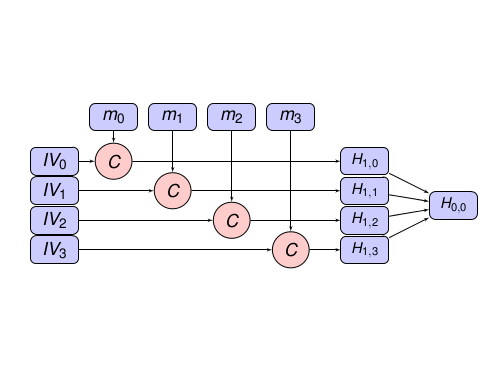(hit the right-arrow key to go to the next slide)
BLAKE2 — an alternative to MD5/SHA-1
Jean-Philippe Aumasson, Samuel Neves, Zooko Wilcox-O'Hearn (that's me!), and Christian Winnerlein
An unmet need
What are SHA-2/SHA-3 used for?
public key digital signatures, HMAC
small inputs, time-insensitive, by cryptographers
What are MD5/SHA-1 used for?
Distributed filesystems, cloud storage, data deduplication, peer-to-peer file-sharing, revision control systems, host-based intrusion detection systems, digital forensics, distributed databases, …
An unmet need
What are SHA-2/SHA-3 used for?
What are MD5/SHA-1 used for?
large inputs, time-sensitive, by engineers
examples: OpenStack, git, ZFS, Perforce, md5sum, BitTorrent, Tahoe-LAFS (that's me again), WinRAR, couchdb, Samhain, NIST recommendations for digital forensics (NIST SP 800-86)
Why use BLAKE1?
- Salsa20 (2005), eSTREAM (co-winner)
- BLAKE1 (2009), SHA-3 contest (finalist)
from Third-Round Report of the SHA-3 Cryptographic Hash Algorithm Competition:
“BLAKE and Keccak have very large security margins.”
“Keccak received a significant amount of cryptanalysis, although not quite the depth of analysis applied to BLAKE.”
Why use BLAKE1?
from Third-Round Report of the SHA-3 Cryptographic Hash Algorithm Competition:
“Skein and BLAKE have the best overall software performance.”
Why didn't NIST use BLAKE1 for SHA-3?
from Third-Round Report of the SHA-3 Cryptographic Hash Algorithm Competition by NIST:
“desire for SHA-3 to complement the existing SHA-2 algorithms … BLAKE is rather similar to SHA-2.”
From BLAKE1 to BLAKE2
- reducing the number of rounds
- tweaks (rotation constants, minimal padding, fewer constants, little-endian)
- parallel mode
- tree mode
BLAKE1 had 14 rounds [*]; BLAKE2 has 10
results
cycles per byte on Intel Core i5-3210M (Ivy Bridge)
function cycles per byte long msg 4096 B 64 B MD5 5.0 5.2 13.1 SHA1 4.7 4.8 13.7 SHA256 12.8 13.0 30.0 Keccak 8.2 8.5 26.0 BLAKE1 5.8 6.0 14.9 BLAKE2 3.5 3.5 9.3
parallel mode

The first users
- compression/archiver tools: WinRAR, Pcompress
- alternative implementations and language bindings: Go, Python, Dart, Node.js, Javascript, PHP…
Go to https://blake2.net to news and information.
Publish papers analyzing BLAKE2's security!